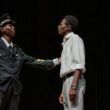Author: Caroline Davis
Publ: Cambridge University Press
This book feels almost unreal, like you’re reading a compelling fictional mystery, the plot of which seems to be complete fantasy rather than true events. But these are the content and claims organised by Caroline Davis in this short book: the history and influence of the CIA in structuring the extensive network of subversion which oriented the process of literary management in Africa.
The book is an engaging and compelling read, with contents that are both distressing and mind-blowing. Davis presents a series of revelations which continued to surprise me as I kept reading. Her accounts are both detailed and concise, making this a short but important read.
While I was shocked, perhaps I should not have been. Scholarship (Douglas, Pietz, Kwon) has defined how the Cold War influenced a US interest in the postcolonial process in Africa, so perhaps it should be obvious that African cultural capital would be a target. It’s saddening, but unsurprising.
This book shows how two front organisations known as the Congress of Cultural Freedom (CCF) and the Farfield Foundation directly enforced and progressed a CIA anti-communist propaganda strategy through managing the scope and influence of authors in Africa. This claim is not only proposed by Davis, who summarises the work of many other scholars contributing to studies of the Postcolonial and Cold War cultural manipulation. This book instead serves as a collection, and brief overview of these ideas: perhaps a platform from which every reader can explore additional critical postcolonial literature.
Davis’ focus is twofold: first, investigating and outlining the ‘transnational networks of African literary publishing in the period of decolonisation’ and second, understanding how authors were shaped by these networks. The authors Wole Soyinka, Nat Nakasa, and Bessie Head feature prominently in this book, all as examples of people who were influenced to a certain degree by these CIA networks.
The true tragedy in these claims is the limitations enforced on the writing and transnational networks of many great historic authors, whose reflections were denied to us. Of greater loss is the hidden literature excluded from the canon of great African literature – the result of not gaining the patronage and support of the CCF.
This book is both a criticism of the CIA cultural agenda, and a reflection of the politics of visibility of African literature.
The chapters outline (expose?) the methods used by the CIA to manage this operation. Chapter one outlines the frames of the African literary publishing world during decolonisation, in line with a dramatic increase in African literature publications during the 1950s and 1960s. Davis maps out the conditions which contributed to the CIA’s migration into cultural management. This was particularly through the influence of international publication networks, which infiltrated existing literary and cultural associations and publishing houses. Their work created a powerful illusion of African-centred autonomous education, media, and publishing houses. In reality, these networks were engineered.
Chapters two, three and four focus more particularly on individual case studies to explain the influence of these networks on an author’s success internationally and locally. Chapter two looks closely at the contribution of the CIA network to Wole Soyinka’s reputation and visibility, arguing that the CIA’s author promotion programme was a significant influence on Soyinka’s reach. It seems a shame for Davis to not expand on the heavy burden which would later be placed on Soyinka to justify a CIA association that he was likely unaware of.
Chapter three looks in detail at the brief but important influence of South African journalist Nat Nakasa, who fell to his death from an apartment in New York in 1965. Due to limited material and discussions, the chapter attempts to outline the CIA’s involvement in Nakasa’s The Classic magazine through analysing the author’s papers. Davis finds that Nakasa was unlikely influenced by the CIA’s agenda in his work for The Classic, and instead provided a platform for more open political discussions. Nakasa seems to have instead been caught between conflicting counter-communist ambitions stemming from both the American and South African states.
Chapter four looks closely at the publishing networks of Bessie Head, who fell on the fringe of CCF support, consistently questioning what it meant to be a ‘genuine African writer’. While Head was a significant and important voice in South African literature, Davis argues that her influence was impeded by not having direct funding and patronage from the CIA.
Davis does an excellent job of simplifying and explaining the breadth and importance of this historic problem; but some claims are a bit more abstract without as many supporting examples. Having said that, this may be the best we can expect when trying to follow cultural espionage (or as she puts it, the ‘cultural Cold War’).
Davis is nonetheless both exact and detailed in tracing routes of influence and power. The extent of the deception against many working within the CIA’s culture networks is both shocking and disheartening. All in all, the book is compelling and well worth a read. Davis ends her book by speaking about the resistance adopted by African writers against the alteration of their work. To this point, I wanted to hear more, and will certainly be exploring more of Davis’ writings.








